#3) gregor is attending a political event of his own accord and is expected to let dara know if anything important happens. as always
Text
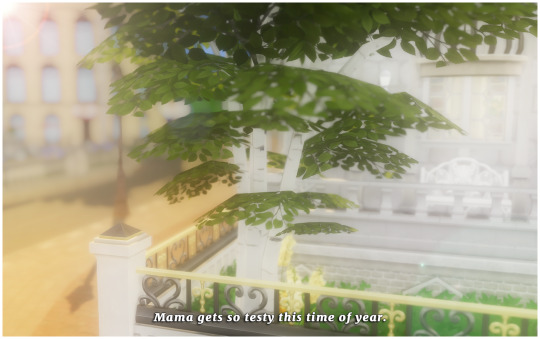

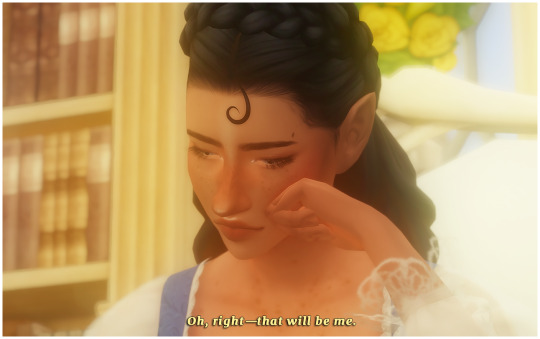
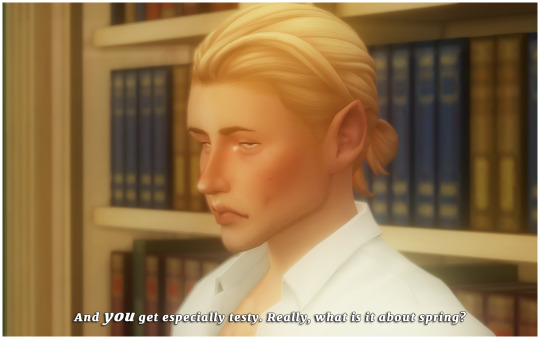
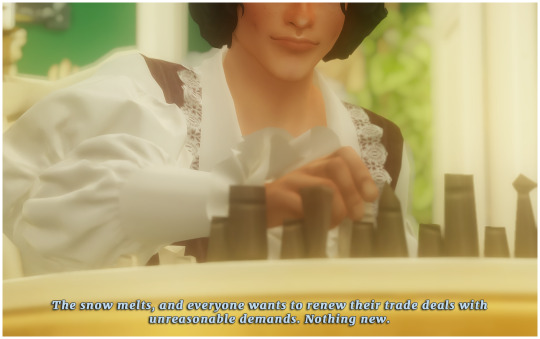
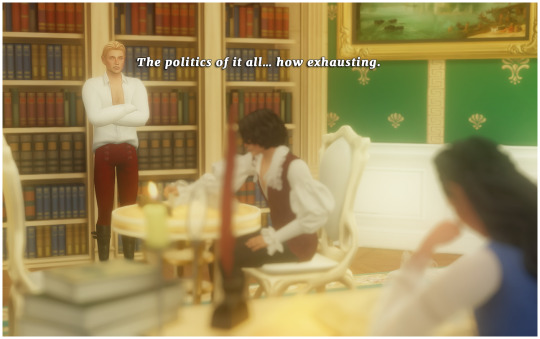
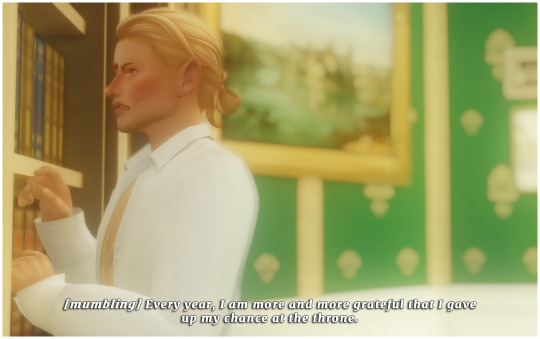
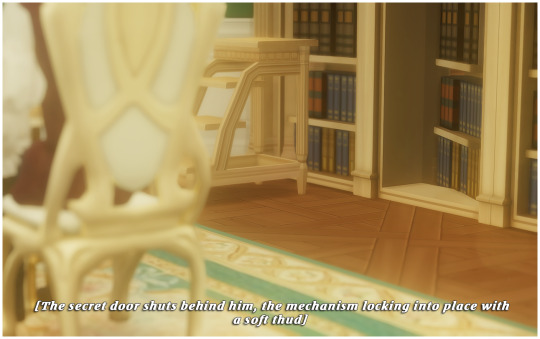



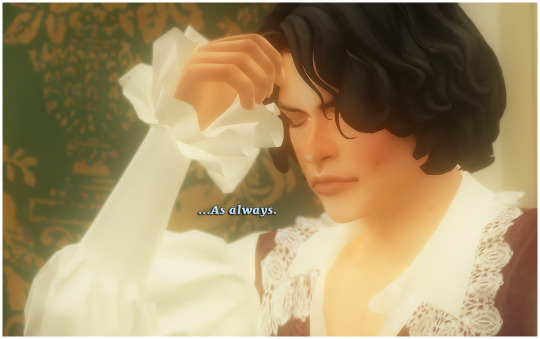

CHAPTER ONE ; 3/3
TRANSCRIPT:
killian: Mama gets so testy this time of year.
dara: Try being Empress to an entire nation. Oh, right—that will be me.
k: And you get especially testy. Really, what is it about spring?
gregor: The snow melts, and everyone wants to renew their trade deals with unreasonable demands. Nothing new.
k: The politics of it all… how exhausting. [mumbling] Every year, I am more and more grateful that I gave up my chance at the throne.
[The secret door shuts behind him, the mechanism locking into place with a soft thud]
g: I will take my leave, as well. How long are you going to be in here?
d: All day. As I am participating in the trade talks this time, I must know everything there is to know.
g: Oh well. I was going to invite you to the luncheon regarding magic reform.
d: Let me know if any good ideas float around, will you?
g: ...As always.
#progeny#ts4 story#some interesting information thrown around in here#1) dara says she is going to be empress and is even taking place in trade talks#2) killian says he gave up the right to the throne a long time ago. obviously he wanted to#3) gregor is attending a political event of his own accord and is expected to let dara know if anything important happens. as always#the secret door leads to the inner walls which leads to the tunnels btw. killian is heading back to training#also revealed: dara has an attitude lol#alright!! till next time!!! spicy things happen in chapter two (^: yknow not THAT kind of spicy but. it's fun
29 notes
·
View notes
Text
Transformative Learning
When I think of a significant transformation, I am reminded of Kafka’s description of Gregor Samsa transforming into a giant insect in the novella The Metamorphosis. Upon reflection of this story, my adult interpretation is that it’s a commentary on the human condition and the mundanity of work. This is just one idea that comes to mind when I first think of transformative learning. However, transformative learning as a theory is about a different kind of change within people. A change that can result in altering perspectives, identity, and even society. Transformative learning theory has been the most popular theory since Knowles popularized andragogy in the 1970s. This theory has to do with how learning shapes people into something different than they were before. Because of this, transformative learning has in many ways replaced andragogy as something unique to adults.
What is Transformative Learning?
Mezirow who first articulated transformative learning as cognitive, rational process, studied the experiences of women who return to school to prepare for jobs. He found that their experience of returning to school made them question assumptions about who they were and how they were products of sociocultural expectations of women at the time.
Mezirow’s early description of transformative learning included a 10-step process beginning with heat he called a “disorienting dilemma.” This is a significant personal life event such as the death of a loved one, losing a job, sustaining a critical injury, etc. Although a disorienting dilemma is often categorized as an “event” it can also be a series of experiences over a span of time that culumate into transformation.
For example:
After being subject to discrimination for a period of time, a woman may begin to question assumptions about equity in society.
Self-examination with feelings of guilt or shame (upset this happened to me)
Questioning is the third step in the process critically assessing the assumptions you have been living with prior to the disorienting dilemma (that all people, regardless of their gender identity, are treated equally).
Recognizing that this discontent is shared (i.e. there are other women who have experienced discrimination because of their gender;
Exploring options for new roles, relationships and actions (i.e. learning about my identity as a woman and building relationships with other women);
Planning a course of action (addressing sexism and gender discrimination in everyday life)
Acquiring knowledge and skills for implementing roles (learning about microaggressions and how to respond to them)
Trying out new roles (calling out a situation when witnessing someone making a sexist remark);
Building confidence in new roles (taking a stand in changing workplace culture)
Reintegrating new perspectives into one’s life (constantly noticing problematic sexist behaviors).
In later writings, Mezirow discuss the role of reflection explaining:
Content reflection is what we perceive, think, feel
Process reflection is how we perceive, think, feel
Premise reflection is why we perceive, think, feel
He also notes that social action is not the goal of transformative learning; rather personal transformation results in connecting with others who have a shared mind which might result in social action.
In contrast to Mezirow’s cognitive and rational process, Drikx considers transformative learning as emotional soul work. In his view, epiphanies are the ego making conscious connection with the psychic content that was previously unconscious. These experiences are connected to emotions such as surprise of excitement. Attending to these emotions or “messengers of the soul” rather than ignoring them is what makes our learning more powerful. For example, the person who experienced discrimination might have a visceral reaction of shame or anger which would need to be attended to, brought into consciousness, and examined as to why they felt this way. Dirkx explains that soul work is not intended to replace the more cognitive understanding of transformative learning but rather make it more holistic.
Transformative Learning can also be viewed from a social change or socio-emancipatory perspective. The primary goal here is to challenge and transform system of oppression. According to Paulo Freire, a person must first become aware of power and oppression in their own lives and them work to change these structures. In Freire’s view the personal is inextricably linked to the political and in order to transform self, one must also transform society. In Freires’s model, conscientization where through dialogue and critical reflection, participants move from fatalistic, passive acceptance or their situation to realizing they can have some influence, to critical consciousness.
Sites of Transformative Learning
Transformative learning has been studied in a myriad of contexts including individual to classrooms.
Individual learning is the heart of the process. No matter if it’s cognitive, emotional “soul work” or social change, transformative learning always begins with the individual.
Higher education is a natural site for transformative learning because it offers an invitation to think, be, and act in new ways. These settings challenge learners to go beyond their learning. Activities to engage learners in transformative learning in the classroom might include dialogue, mentoring, experiential learning, and using art.
When teaching online, Dirkx suggests incorporating the six instructional design elements: (1) use of messy, practice-based problems (2) interactive and collaborative learning (3) group writing (4) individual and group debrief (5) reflective activities and (6) journaling.
Adults spend most of their time in work-related activities. While transformative learning isn’t always central in the workplace, it can usually emerge when getting workers to reflect on their role in perpetuating inequitable practices in the workplace. Brookfield explains that critical reflection in the workplace can be a very difficult process as workers are often, by virtue of their roles, colluding in their own oppression. Critical reflection in these moments can be in opposition to the interests of the company or organization.On the basic level, it’s important for workers to challenge the “this is the way things are” model by at least asking the question “why.” Some strategies that might lead to transformative learning in the workplace include modeling and peer learning, storytelling and dialogue ,coaching, and action learning.
A community itself can be a site for transformative learning. Community activists and social activists seeks a transformation at the community or societal level (Me Too Movement, Black Lives Matter, Climate Change, etc.). The goal of these individuals participating in movements is to create broader social change which, given what has been shared about transformative learning and the individual, links back to the people behind the movement having experienced some type of transformation. A movement can also be a trigger for an individual’s transformation as well.
Promoting & Evaluating Transformative Learning
There are several underlying components of instruction necessary to facilitate transformative learning including critical reflection, storytelling, artistic expression, dialogue, the facilitator intentionally creating space for transformative learning.
While there are many pedagogical strategies to engage transformative learning, there are very few ways to evaluate this type of learning. Some scholars have argued that transformative learning doesn’t exist because it can’t be evaluated. However, there are ways in which to assess or evaluate this process. One method is to use interviews with learners and ask them to tell their stories. Keep in mind that Mezirow himself first development this theory after interviewing a group of women.
In many ways, the emancipatory nature of transformative learning is deeply personal and varies according to each individual. As a result, an instructor can not necessarily state that transformative learning will be an “learning outcome.” Educators can create an environment to foster transformative learning but can not make it happen. In these settings, the instructor can usually determine if transformative learning has occurred based on the learners shift in perspective.
Critiques of Transformative Learning
Newman, the critic who questioned if transformative learning exists because it can’t be evaluated, wrote an article which essentially stated that people are applying the label of transformative learning to all types of learning. Additional, Newman raises questions about transformative learning failing to differentiate between the transformation of identity or consciousness, if learning is finite or flowing, if there are ideal conditions for discourse to exist, if mobilization is necessary, and the inclusion of spirituality in the discourse of transformative learning. Many respondents to Newman state that he relied heavily on Mezirow’s early work.
Nevertheless, some of the critiques are valid. For example, is transformative learning really a linear 10-step process as defined by Mezirow or can individuals move back and forth through various stages. Once a transformation has occurred, can it be reversed. For example, a politically moderate person has an experience which leads them to become more radical and then, at some point, they revert back to a moderate.
Another assumption is that transformative learning results in a more open and inclusive perspective. But what happens when the disorienting dilemma, such as an assault, results in a transformative where a person as a fear of a particular group of people. This could potentially result in the development of bias instead of a more “open” perspective.
There is also the important ethical questions of facilitators as change agents. What if, for example a person works with victims of domestic violence and transform them to become empowered. However, the result might be that they require to their abuser. What are the ethical considerations for this type of transformation? An important part of being ethical is remaining transparent about your role as an educator in these spaces and set the stage for open dialogue to discuss these important issues.
Theory to Practice
Tell a story about a time you have experienced transformative learning. Did your experience follow the series of steps outlined by Mezirow?
For fun, read The Metamorphosis by Franz Kafka. The last time I read this was in grade school so re-reading as a working adult has an entirely different meaning and interpretation: https://www.planetebook.com/free-ebooks/the-metamorphosis.pdf
0 notes